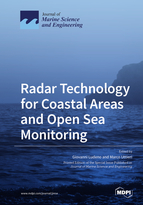Radar Technology for Coastal Areas and Open Sea Monitoring
A special issue of Journal of Marine Science and Engineering (ISSN 2077-1312). This special issue belongs to the section "Ocean Engineering".
Deadline for manuscript submissions: closed (31 January 2020) | Viewed by 42598
Special Issue Editors
Interests: ocean monitoring; radar imaging; surface waves; ocean engineering; inverse problems; coastal bathymetry; microwave tomography
Special Issues, Collections and Topics in MDPI journals
Interests: zooplankton ecology; behaviour; numerical analysis
Special Issues, Collections and Topics in MDPI journals
Special Issue Information
Dear Colleagues,
Monitoring oceans and coastal areas has a fundamental social impact and this scenario is made still more challenging with regard to the present and future issues related to climate change. In this context, radar systems have gained increasing interest, since they are remote sensing devices capable of providing information about sea waves, currents, tides, bathymetry, and wind. Moreover, radar systems can be designed to perform both large-scale and small-scale monitoring, with different spatial and temporal resolutions, and can be installed on different observation platforms (ship-based, ground-based, airborne, satellite or drones).
The Special Issue aims at engendering a virtual forum for ocean radar researchers where state-of-the-art methodologies and applications concerning ocean monitoring are reviewed and discussed. Possible topics for the Special Issue include, but are not limited to:
- radar system design;
- signal processing;
- ocean dynamics;
- open sea and coastal areas monitoring;
- physical–biological interactions;
- sea safety and protection.
Dr. Giovanni Ludeno
Dr. Marco Uttieri
Guest Editors
Manuscript Submission Information
Manuscripts should be submitted online at www.mdpi.com by registering and logging in to this website. Once you are registered, click here to go to the submission form. Manuscripts can be submitted until the deadline. All submissions that pass pre-check are peer-reviewed. Accepted papers will be published continuously in the journal (as soon as accepted) and will be listed together on the special issue website. Research articles, review articles as well as short communications are invited. For planned papers, a title and short abstract (about 100 words) can be sent to the Editorial Office for announcement on this website.
Submitted manuscripts should not have been published previously, nor be under consideration for publication elsewhere (except conference proceedings papers). All manuscripts are thoroughly refereed through a single-blind peer-review process. A guide for authors and other relevant information for submission of manuscripts is available on the Instructions for Authors page. Journal of Marine Science and Engineering is an international peer-reviewed open access monthly journal published by MDPI.
Please visit the Instructions for Authors page before submitting a manuscript. The Article Processing Charge (APC) for publication in this open access journal is 2600 CHF (Swiss Francs). Submitted papers should be well formatted and use good English. Authors may use MDPI's English editing service prior to publication or during author revisions.
Keywords
- radars
- remote sensing
- ocean and coastal monitoring
- ecological applications of radars
- signal processing
- ocean radar system design
- coastal areas safety and protection







